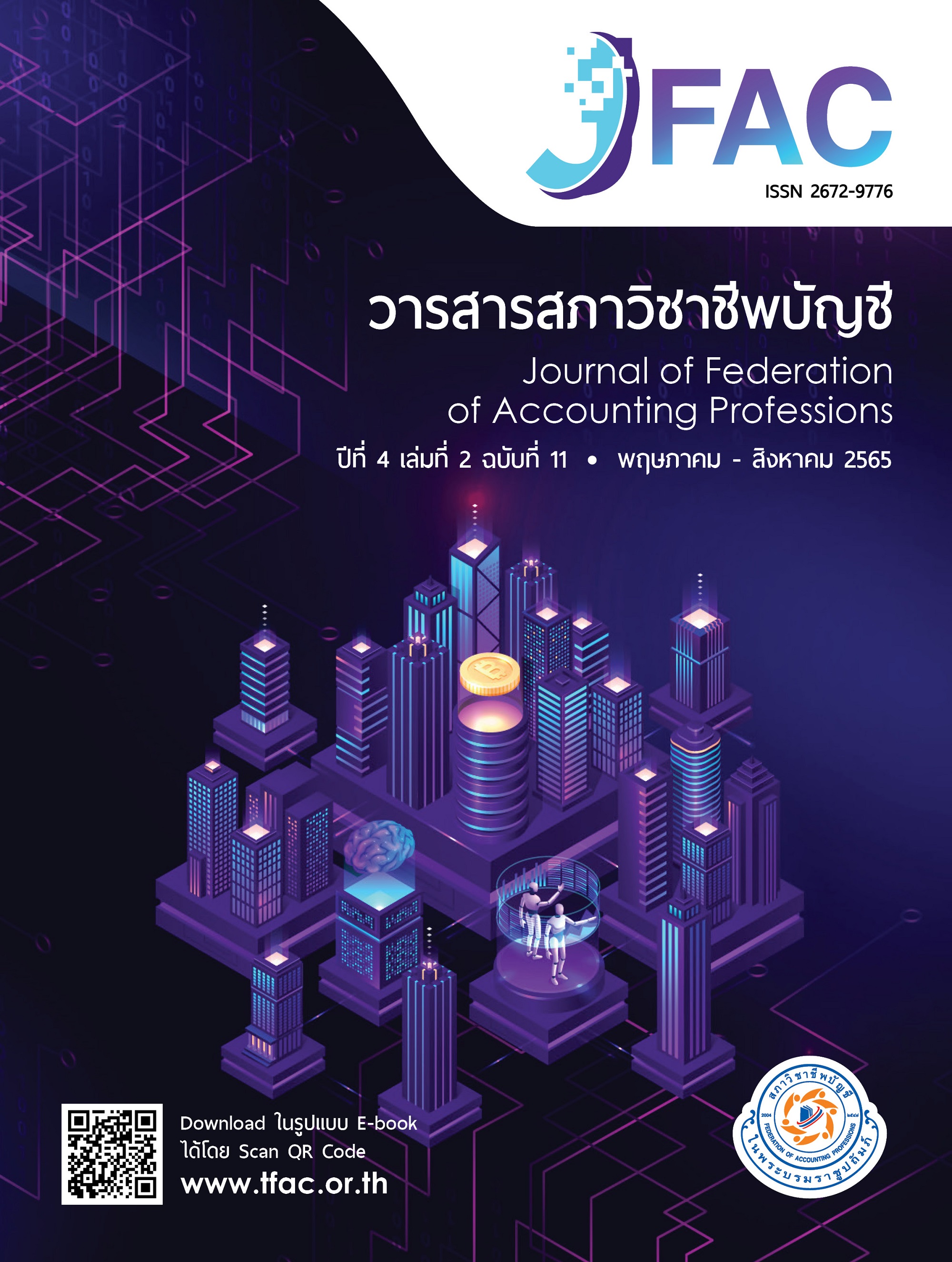แนวทางการประเมินและตอบสนองความสี่ยงการตรวจสอบบัญชีคริปโทเคอร์เรนซีด้านผู้ถือสินทรัพย์
Main Article Content
บทคัดย่อ
การศึกษานี้มีวัตถุประสงค์เพื่อพัฒนาแนวทางในการระบุและประเมินความเสี่ยง และการตอบสนองความเสี่ยงในการตรวจสอบ รวมถึงระบุปัจจัยสำคัญที่มีผลต่อการวางแผนการตรวจสอบของบัญชีคริปโทเคอร์เรนซีด้านผู้ถือสินทรัพย์ การศึกษาครั้งนี้ใช้วิธีการเก็บรวบรวมข้อมูลด้วยแบบสอบถามจากผู้สอบบัญชีรับอนุญาตและผู้ช่วยผู้สอบบัญชีที่มีประสบการณ์ในการตรวจสอบบัญชีดังกล่าว การวิเคราะห์ข้อมูลใช้สถิติเชิงพรรณนา ได้แก่ ค่าเฉลี่ย ค่าต่ำสุด และค่าสูงสุด และสถิติเชิงอนุมาน ได้แก่ Mann-Whitney U test และ Kruskal-Wallis one way analysis of variance test
ผลการศึกษาพบว่าผู้ตอบแบบสอบถามให้ความสำคัญกับการทดสอบการควบคุมมากกว่าการระบุและประเมินความเสี่ยง และการตรวจสอบเนื้อหาสาระ โดยประเด็นที่ให้ความสำคัญมากที่สุด คือ การทดสอบความมีประสิทธิผลของการควบคุมเกี่ยวกับการอนุมัติเพื่อเข้าทำรายการที่เกี่ยวข้องกับคริปโทเคอร์เรนซี และการทดสอบความมีประสิทธิผลของระบบการควบคุมการป้องกันการเข้าถึง Private keys ส่วนประเด็นที่ให้ความสำคัญน้อยที่สุด คือ การตรวจสอบรายชื่อคู่สัญญาที่ได้รับอนุมัติ และตรวจสอบว่ามีการเข้าทำรายการเกี่ยวกับคริปโทเคอร์เรนซีกับคู่สัญญาที่ไม่ได้รับอนุมัติ นอกจากนี้ การศึกษาปัจจัยที่มีผลต่อการกำหนดแนวทางการตรวจสอบที่ระดับความมีนัยสำคัญ 0.05 พบว่าปัจจัยที่มีผลต่อการกำหนดแนวทางในการตรวจสอบ ได้แก่ ระดับการศึกษา ประสบการณ์ทำงานด้านการสอบบัญชี ประเภทสำนักงานตำแหน่งงานปัจจุบัน และจำนวนบริษัทที่รับผิดชอบในการตรวจสอบบัญชี การศึกษานี้เป็นประโยชน์ต่อผู้สอบบัญชีในการวางแผนการตรวจสอบบัญชีคริปโทเคอร์เรนซีด้านผู้ถือสินทรัพย์
Article Details
เนื้อหาและข้อมูลในบทความที่ลงตีพิมพ์ในวารสารสภาวิชาชีพบัญชี ถือเป็นข้อคิดเห็นและความรับผิดชอบของผู้เขียนบทความโดยตรงซึ่งกองบรรณาธิการวารสารไม่จำเป็นต้องเห็นด้วยหรือร่วมรับผิดชอบใด ๆ
บทความ ข้อมูล เนื้อหา รูปภาพ ฯลฯ ที่ได้รับการตีพิมพ์ในวารสารสภาวิชาชีพบัญชี ถือเป็นลิขสิทธิ์ของวารสารสภาวิชาชีพบัญชี หากบุคคลหรือหน่วยงานใดต้องการนำข้อมูลทั้งหมดหรือบางส่วนไปเผยแพร่ต่อหรือเพื่อกระทำการใดๆ จะต้องได้รับอนุญาตเป็นลายลักษณ์อักษรจากวารสารสภาวิชาชีพบัญชี ก่อนเท่านั้น
เอกสารอ้างอิง
AICPA and CIMA (2020). Accounting for and auditing of digital assets. Retrieved from https://us.aicpa.org/content/dam/aicpa/interestareas/informationtechnology/downloadabledocuments/accounting-for-and-auditing-of-digital-assets.pdf
Bangkok Business (2021). How is Bitcoin invested. Knowing beforehand has an advantage in 2021. Retrieved from http://www.bangkokbiznews.com/news/detail/918610
Chartered Professional Accountants of Canada (2018). Audit considerations related to cryptocurrency assets and transactions. Retrieved from https://www.cpacanada.ca/en/ business-and-accounting-resources/audit-and-assurance/canadian-auditing-standards-cas/publications/cryptocurrency-audit-considerations
Chantabutr, P., Jaensirisak, S & Sawettham, A (2021). Blockchain Technology: Concept and Its Implications for Accounting, Auditing and Supply Chain Management. Journal of Accounting Profession, 17(56). 84-89.
Deloitte (2017). Break Through with Blockchain. Retrieved from http://www.2.deloitte.co,/us/en/pages/financial-services/articles/blockchain-series-deloitte-center-for financialservices.html
Deloitte (2018). Cryptocurrency: Financial reporting implications. Retrieved from https://www.iasplus/com/en/
publications/global/thinking-allowed/2018/thinking-allowed-cryptocurrency-financial-reporting-implications
EY (2021). Accounting by holders of crypto-assets (Updated October 2021). Retrieved from
Federation of Accounting Professions (TFAC) (2020). Thai Standards on Auditing (TSA) 315 (Revised), Identifying and Assessing the Risks of Material Misstatement through Understanding the Entity and Its Environment. Retrieved from https://www.tfac.or.th.
Federation of Accounting Professions (TFAC) (2020). Thai Standards on Auditing (TSA) 330 (Revised), The Auditor’s Responses to Assessed Risks. Retrieved from https://www.tfac.or.th.
IFRS Interpretations Committee (2019). Agenda decision on Holdings of cryptocurrencies. Retrieved from https://www.ifrs.org/content/dam/ifrs/supporting-implementation/agenda-decisions/2019/holdings-of-cryptocurrencies-june-2019.pdf
KPMG (2019). Cryptoassets–Accounting and tax: What’s the impact on your financial statements? Retrieved from https://assets.kpmg/content/dam/kpmg/xx/pdf/2019/04/cryptoassets- accountingaccounting-tax.pdftax.pdf
Mitrapanont, K (2020). Summary of the key points from the discussion of Auditor’s Challenge with AI and Blockchain Technology Part 1. Retrieved from https://www.tfac.or.th/en/Article/Detail/124106
Nishani, Edirisinghe Vincent & Wilkins, Anne M. (2020). Challenges when Auditing Cryptocurrencies. American Accounting Association: Current Issues in Auditing, 14(1), 46 -58.
Palfreyman, J. (2017). Blockchain for government: Building trust, demolishing bureaucracy. Retrieved from https://www.ibm.com/blogs/blockchain/2017/02/blockchain-governmentbuilding-trust- demolishing-bureaucracy/
Phaukjig, P. (2021). Cryptocurrency and Taxation. Tax Policy Journal, 2(19), 1–3.
PwC (2019). Cryptographic assets and related transactions: accounting considerations under IFRS. Retrieved from https://www.pwc.com/gx/en/audit-services/ifrs/publications/ifrs-16/cryptographic-assets-related-transactions-accounting-considerations-ifrs-pwc-in-depth.pdf
Siam Blockchain (2017). What is Blockchain technology and how it can change the world. Retrieved from http://www.siamblockchain.com/2017/06/04/blockchain-A3/
Sincharoonsak, T. & Nakavisute, I. (2020). Effect of blockchain on accounting information security.
Journal of MCU Nakhondhat, 7(5), 1–11.
U.S. Government Accountability Office (2019). Blockchain & Distributed Ledger Technologies. Retrieved from https://www.gao.gov/products/gao-19-704sp.

